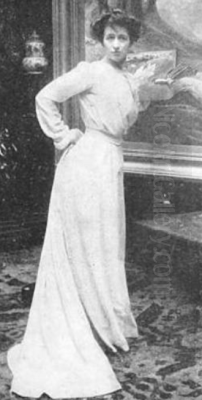
Maud Earl stands as one of the preeminent figures in the specialized field of canine art. Active during the late Victorian and Edwardian eras and into the early 20th century, this British-American artist carved a unique niche for herself, achieving international recognition for her remarkably lifelike and characterful portraits of dogs. At a time when professional female artists faced significant hurdles, Earl not only succeeded but excelled, gaining patronage from the highest levels of society, including the British Royal Family. Her legacy is built on a foundation of rigorous anatomical understanding, keen observation, and an undeniable passion for her subjects, leaving behind a body of work that continues to captivate dog lovers and art collectors alike.
Early Life and Artistic Foundations
Alice Maud Earl was born in Marylebone, London, in 1864, into a family deeply immersed in the art world. Her father, George Earl, was a noted sporting and animal painter, known for his depictions of dogs and field sports. Her mother was George's first wife, Alice Beaumont Rawlins. The artistic lineage extended further, with her uncle, Thomas Earl, also being a respected painter often focusing on animal subjects. This environment undoubtedly nurtured Maud’s burgeoning talent from a very young age.
Recognizing her aptitude, George Earl took his daughter under his wing, becoming her first and most influential teacher. Crucially, he emphasized the importance of anatomical study. Maud was rigorously schooled in the underlying structure of the canine form – bones, muscles, and how they dictated movement and posture. This grounding in anatomy became a cornerstone of her artistic practice, differentiating her work through its accuracy and convincing realism. She learned not just to capture a likeness, but to understand the physical essence of the animals she portrayed.
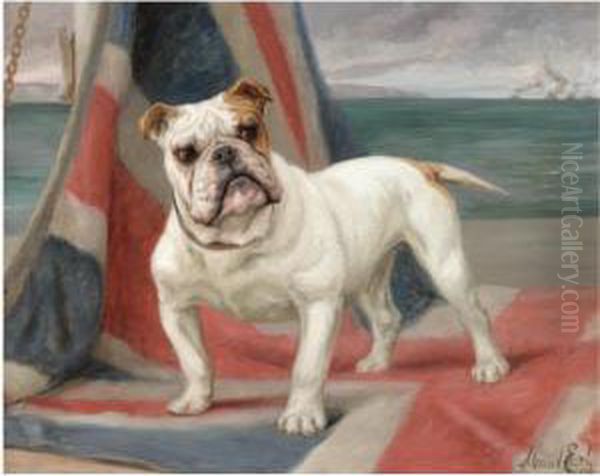
To further hone her skills, Maud Earl attended the Royal Female School of Art, an institution later incorporated into the Central School of Arts and Crafts. This formal training complemented the practical instruction received from her father, refining her technique and broadening her artistic horizons. By the time she began exhibiting professionally, Earl possessed a formidable combination of inherited artistic sensibility, rigorous anatomical knowledge, and polished technical skill, perfectly positioning her for a career focused on the animal she clearly loved most: the dog.
Ascendancy in the British Art Scene
Maud Earl’s professional career took flight in the 1880s. She began exhibiting her work at prestigious London venues, most notably the Royal Academy, where she showed paintings regularly from 1884. Her work also graced the walls of the Royal Society of British Artists and even crossed the Channel to be displayed at the renowned Paris Salon. This early exposure in such respected forums quickly established her reputation as a serious and highly skilled artist.
Her specialization in canine portraiture coincided with a surge in popularity for purebred dogs and dog shows in Victorian Britain. This cultural phenomenon created a fervent market for accurate and aesthetically pleasing depictions of champion animals and beloved pets. Earl’s ability to capture not only the physical characteristics conforming to breed standards but also the individual personality and spirit of each dog set her apart. Her portraits were more than mere records; they were insightful studies of character.
This talent did not go unnoticed by the highest echelons of society. Earl secured commissions from prominent figures, including members of the British Royal Family. Queen Victoria herself became a patron, as did Queen Alexandra (when Princess of Wales) and later, King Edward VII. Royal patronage was the ultimate validation in Victorian and Edwardian society, cementing Earl's status as the foremost dog painter of her time. Her ability to satisfy such discerning clients speaks volumes about her artistic prowess and professional acumen.
A significant milestone occurred in 1897 when Earl held a major solo exhibition in London, showcasing an impressive collection of paintings depicting forty-eight distinct breeds of dog. This ambitious undertaking demonstrated her versatility and deep knowledge across the canine spectrum, further solidifying her reputation and attracting widespread acclaim. By the turn of the century, Maud Earl was a celebrated figure in the British art world, renowned for her unparalleled skill in capturing the essence of dogs on canvas.
The Evolution of Earl's Artistic Style
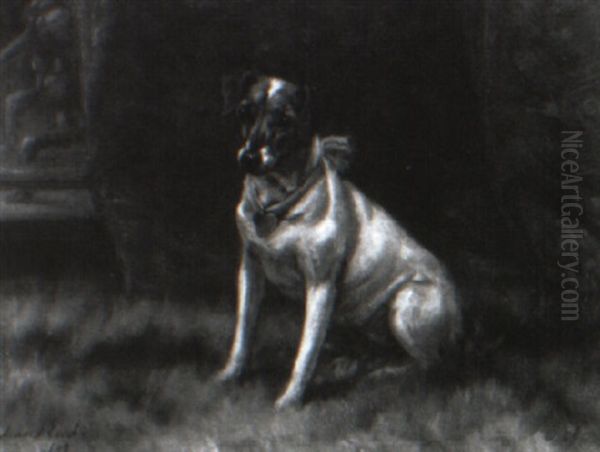
Maud Earl’s artistic journey was not static; her style evolved over her long career, often categorized into distinct phases reflecting her changing interests and perhaps external influences. Her deep understanding of anatomy remained a constant, but her approach to paint application, composition, and mood shifted over time.
Her earliest professional works, spanning roughly from the 1880s to around 1900, are characterized by a rich, detailed naturalism. During this period, her rigorous training under her father is most evident. The paintings are meticulously rendered, with careful attention paid to the texture of fur, the structure of bone and muscle beneath the skin, and the accurate depiction of breed standards. The colours are often vibrant, and the settings, while sometimes simple, are rendered with a similar naturalistic fidelity. Works from this era showcase her mastery of traditional techniques.
From around 1900 to 1915, a subtle shift occurred. While still highly detailed and anatomically sound, Earl's brushwork began to loosen slightly. There is a greater sense of freedom and fluidity in these paintings. The focus remains squarely on the dog, but the overall effect can feel more painterly and less rigidly defined than her earliest pieces. This period saw the creation of some of her most iconic and dynamic portraits, capturing dogs in moments of alertness or quiet contemplation with remarkable vitality.
Following her move to the United States in 1916, Earl entered what she termed her "Oriental style" phase. These works, created during the late 1910s and 1920s, often feature dogs against decorative, stylized backgrounds, sometimes incorporating screens, fabrics, or motifs inspired by East Asian art. The compositions became more consciously designed, moving away from pure naturalism towards a more aestheticized presentation. This marked a significant departure, reflecting perhaps a desire to explore new artistic avenues in her new environment.
In the final phase of her career, during the 1930s, Earl's work took another turn, becoming somewhat more stylized and even abstract, particularly when compared to her early realism. Alongside her continued dog portraiture, she also produced a series of delicate and beautifully observed sketches of birds during this time. This later work demonstrates her continued artistic exploration even into her senior years. Throughout all these phases, however, her fundamental ability to capture the unique character and presence of her animal subjects remained her defining strength.
Representative Works and Publications
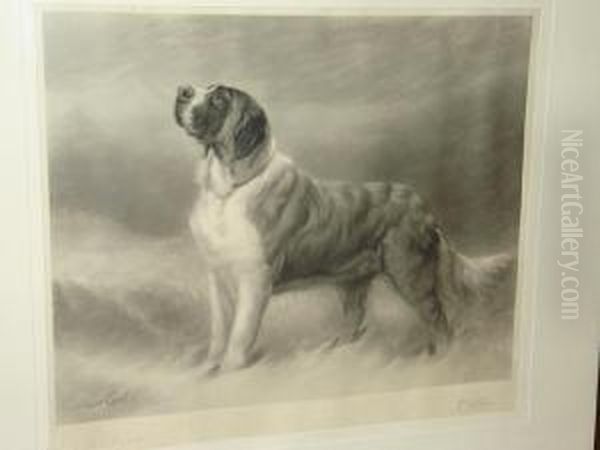
Several specific works stand out in Maud Earl's extensive oeuvre, highlighting her skill and the different facets of her career. One of her most famous early paintings is 'Champion Dimboola', often simply referred to as 'The Bulldog' (1896). This portrait of a prize-winning Bulldog, set against a backdrop featuring the White Cliffs of Dover and a Union Jack flag, became an iconic image of British national pride and canine strength at the turn of the century. Its widespread reproduction cemented Earl's popular fame.
Another significant work is 'White Light' (circa 1910). This large and imposing painting, nearly five feet tall, depicts an alert white Greyhound or similar sighthound standing dramatically against a backdrop of crashing waves and a turbulent sky. It showcases Earl's ability to create atmosphere and mood, moving beyond simple portraiture. For many years, this painting hung in a private residence before eventually finding a home in the collection of the American Kennel Club Museum of the Dog, a testament to its enduring power.
Her royal commissions also resulted in notable pieces, such as the portrait titled 'Jack', depicting an Irish Terrier belonging to a member of the Irish royalty. Works like this demonstrate her skill in capturing the specific points of a breed while satisfying the expectations of elite patrons. These commissions required not only artistic talent but also a degree of diplomacy and understanding of the world of dog fanciers.
Beyond individual canvases, Earl's work reached a wide audience through publications. She provided twelve illustrations for the book A Twelvemonth of Sport in Ireland (edited by E. T. H. Walker), which were reproduced as etchings. Her work was also featured in publications like The Sportsman's Yearbook. These reproductions, often issued as prints, made her art accessible beyond the wealthy collectors who could afford original paintings, significantly broadening her influence and reputation both in Britain and internationally.
The Transatlantic Shift: Life and Art in America
The outbreak of the First World War profoundly impacted Maud Earl, as it did countless others. She reportedly felt that the war had irrevocably changed the world she knew and perhaps disrupted the patronage system she relied upon in Britain. Seeking a new environment, she made the significant decision to emigrate, moving to New York City around 1915 or 1916.
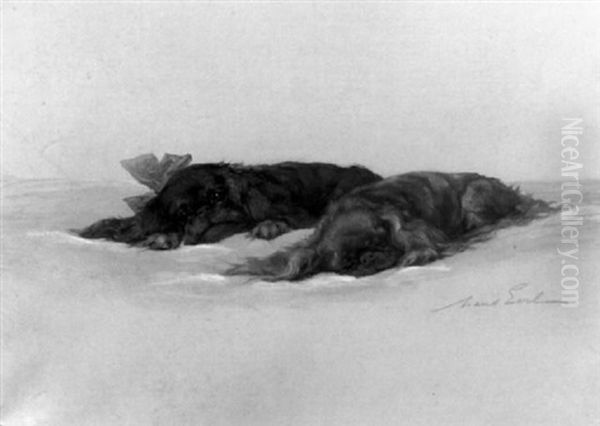
In New York, Earl established a new studio and continued her career as an animal painter. This move marked the beginning of her "Oriental style" period, suggesting she embraced the change of scenery as an opportunity for artistic experimentation. America, with its own growing class of wealthy industrialists and dog enthusiasts, provided a fresh market for her work. She continued to receive commissions and exhibit, maintaining her professional standing on a new continent.
Details about her personal life remain relatively scarce, as she seems to have been quite private. She never married and dedicated her life almost entirely to her art. Her New York studio became her base of operations for the remainder of her career. She adapted to her new surroundings, navigating the American art scene and continuing to produce portraits that were highly sought after by dog owners and collectors.
Even in her later years in the US, she continued to explore artistically, moving towards more stylized depictions and taking up bird sketching in the 1930s. Maud Earl remained in New York until her death in 1943. She passed away at the age of 79 and was buried in the historic Sleepy Hollow Cemetery in Sleepy Hollow, New York, leaving behind a legacy established on two continents.
Contemporaries and Artistic Context
Maud Earl practiced her art during a vibrant period for animal painting, particularly in Britain. She was part of a rich tradition but also stood out within it. Her father, George Earl, and uncle, Thomas Earl, were direct influences and contemporaries within her own family. Her brother, Thomas William Earl, also pursued dog painting, and a cousin, Percy Hallam, was an animal painter, making the Earls a significant family dynasty in the genre.
Beyond her family, the towering figure of Sir Edwin Landseer (1802-1873) cast a long shadow over Victorian animal painting. Landseer was famed for his technical brilliance and his often sentimental or anthropomorphic depictions of animals, most famously stags and dogs like the Newfoundland. While Earl certainly respected anatomical accuracy, her work generally avoided the overt narrative sentimentality often found in Landseer, focusing more on the specific character and breed points of the individual dog.
Other notable contemporaries specializing in animal or sporting art included Briton Rivière (1840-1920), known for his dramatic paintings often featuring animals alongside human figures in historical or mythological settings. John Emms (1844-1912) was a closer competitor in the specific field of dog portraiture, particularly known for his vigorous paintings of hounds and terriers. Arthur Wardle (1860-1949) was another prolific contemporary animal painter, admired for his versatility and accuracy in depicting a wide range of animals, including big cats as well as dogs.
The broader field included artists like Richard Ansdell (1815-1885), a successful painter of animals and Scottish scenes, and John Frederick Herring Sr. (1795-1865), primarily a horse painter but influential in sporting art. Artists like Heywood Hardy (1842-1933), Wright Barker (1864-1941), and George Armfield (fl. 1840-1875) also contributed significantly to the genre of sporting and animal painting during this era. It's also worth noting the immense success of the French animal painter Rosa Bonheur (1822-1899), whose international fame demonstrated that women could achieve the highest levels of recognition in this field.
Earl's focus on purebred dogs aligned perfectly with the rise of organizations like The Kennel Club (founded in Britain in 1873) and the increasing codification of breed standards. Her work provided visual documentation and celebration of these standards, appealing directly to the breeders, exhibitors, and enthusiasts driving this movement. She operated within a competitive field but distinguished herself through her technical foundation, royal connections, and the sheer quality and consistency of her canine portraits, arguably surpassing many contemporaries in her specific niche. Predecessors like George Stubbs (1724-1806), with his foundational work in equine anatomy, and Philip Reinagle (1749-1833), known for sporting dogs, had laid the groundwork for the kind of anatomical fidelity Earl pursued.
Legacy and Enduring Reputation
Maud Earl's contribution to canine art is widely regarded as exceptional. She is consistently ranked among the most important and skilled dog painters of the 19th and early 20th centuries. Her dedication to the genre, combined with her technical mastery and insightful portrayal of canine character, secured her a lasting place in art history. Collectors and curators specializing in animal art often consider her work unparalleled in its specific focus.
Her emphasis on anatomical accuracy, instilled by her father, provided a foundation that lent her portraits profound realism and authority. Yet, her work was not merely clinical; she possessed a remarkable ability to convey the personality, mood, and vitality of each individual dog. Whether capturing the alert intensity of a terrier, the noble bearing of a sighthound, or the sturdy presence of a bulldog, Earl imbued her subjects with life. Some critics have noted a subtle humour or humanizing quality in her depictions, adding another layer of appeal.
The fact that she achieved such prominence as a female artist in the male-dominated Victorian and Edwardian art world is also significant. While animal painting was perhaps seen as a more acceptable field for women than historical or allegorical subjects, Earl's level of professional success, including major exhibitions and royal patronage, was remarkable for her time. She navigated the art market successfully, building a sustainable career through commissions and the sale of reproductions.
Today, Maud Earl's original paintings are highly sought after by collectors and institutions. Her work is represented in museum collections, notably the American Kennel Club Museum of the Dog in New York, which holds important examples like 'White Light'. The continued popularity of prints after her paintings further attests to the enduring appeal of her images. She remains a benchmark against which other dog painters are often measured, celebrated for her technical skill, her deep understanding of her subjects, and her significant contribution to the visual culture surrounding man's best friend.
Conclusion
Maud Earl dedicated her life to the art of canine portraiture, elevating the genre through her exceptional skill, keen observation, and unwavering focus. From her early training in anatomy under her artist father to her rise through the ranks of the London art world, securing royal patronage, and her later career in America, she consistently produced work of the highest quality. Her ability to capture both the physical form and the intangible spirit of dogs remains remarkable. Spanning distinct stylistic phases yet always grounded in realism and empathy, her paintings offer an enduring testament to the unique bond between humans and dogs. As one of the foremost animal painters of her era, and arguably the preeminent female dog painter of the 19th century, Maud Earl's artistic legacy continues to be admired and celebrated on both sides of the Atlantic.